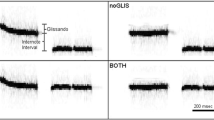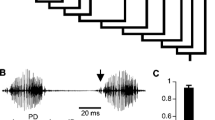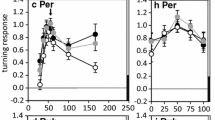Summary
-
1.
The phonotactic tracking behavior of females on a locomotion compensator was studied in the field cricket,Gryllus bimaculatus DeGeer. Synthetic stimuli were played back in choice and no-choice experiments to determine the behavioral tuning to calling song temporal properties.
-
2.
In ‘to-and-fro’ sequential tests, best tracking occurred when stimuli had syllable periods between 35 and 50 ms (Figs. 2, 3). The variability of tracking scores within and among individuals was lowest when syllable periods were 40 and 45 ms, indicating an even narrower tuning to syllable period.
-
3.
Context-dependent after-effects were seen in some females (Figs. 2, 3). That is, the range of syllable periods tracked by females in sequential experiments was broad or narrow, depending upon the order of stimulus presentation (i.e. from ‘unattractive’ to ‘attractive’ syllable periods or vice versa (see Fig. 3)).
-
4.
In choice experiments, the optimal range of syllable periods was similar to that found in to-and-fro sequential (no-choice) experiments. As the syllable period of the alternative stimulus was moved farther away from that of the standard stimulus (45 ms), the preference for the standard persisted even when its SPL was attenuated by5 to 20 dB relative to the SPL of the alternative (Fig. 4).
-
5.
Several females tracked both the standard and alternative stimuli in sequential ‘pre-tests’, but clearly preferred (tracked) the standard over the alternative in subsequent choice tests (Figs. 5–9). This difference in the results of choice and nochoice experiments was most prominent when the alternative syllable period was between 55 and 60 ms (Fig. 10). These results can be explained by recent findings of trade-off phenomena in calling song recognition inG. bimaculatus.
Similar content being viewed by others
Abbreviations
- SP :
-
syllable period
- SD :
-
syllable duration
- CP :
-
chirp period
- CD :
-
chirp duration
- SN :
-
syllable number
References
Alexander RD, Moore TE (1962) The evolutionary relationship of 17- and 13-year cicadas, and three new species. Mise Publ Mus Zool Univ Michigan 121:5–59
Doherty JA (1985a) Temperature coupling and trade-off phenomena in the acoustic communication system of the cricket,Gryllus bimaculatus DeGeer. J Exp Biol 114:17–35
Doherty JA (1985b) Trade-off phenomena in calling song recognition and phonotaxis in the cricket,Gryllus bimaculatus (Orthoptera, Gryllidae). J Comp Physiol A 156:787–801
Doherty JA, Huber F (1983) Temperature effects on acoustic communication in the cricketGryllus bimaculatus DeGeer. Verb Dtsch Zool Ges 1983:188
Doherty JA, Gerhardt HC (1984) Evolutionary and neurobiological implications of selective phonotaxis in the spring peeper (Hyla crucifer). Anim Behav 32:875–881
Doolan JM, Pollack GS (1985) Phonotactic specificity of the cricketTeleogryllus oceanicus: intensity-dependent selectivity for temporal parameters of the stimulus. J Comp Physiol A
Gerhardt HC (1974) The significance of some spectral features in mating call recognition in the green treefrog (Hyla einerea). J Exp Biol 61:229–241
Gerhardt HC (1976) Significance of two frequency bands in long distance vocal communication in the green treefrog. Nature 261:692–694
Gerhardt HC (1978) Discrimination of intermediate sounds in a synthetic call continuum by female green tree frogs. Science 199:1089–1091
Gerhardt HC (1981a) Mating call recognition in the green treefrog (Hyla cinered): Importance of two frequency bands as a function of sound pressure level. J Comp Physiol 144:9–16
Gerhardt HC (1981b) Mating call recognition in the barking treefrog (Hyla gratiosa): Responses to synthetic calls and comparisons with the green treefrog (Hyla cinered). J Comp Physiol 144:17–25
Gerhardt HC (1982) Sound pattern recognition in some North American treefrogs (Anura: Hylidae): Implications for mate choice. Am Zool 22:581–595
Gerhardt HC (1983) Acoustic communication in treefrogs. Verb Dtsch Zool Ges 1983:25–35
Gerhardt HC, Rheinlaender J (1982) Localization of an elevated sound source by the green treefrog. Science 217:663–664
Helversen D von (1984) Parallel processing in auditory pattern recognition and direction analysis by the grasshopperChorthippus biguttulus L. (Acrididae). J Comp Physiol A 154:837–846
Hoy RR, Paul RC (1973) Genetic control of sound specificity in crickets. Science 180:82–83
Oldham RS, Gerhardt HC (1975) Behavioral isolating mechanism of the treefrogsHyla cinerea andH. gratiosa. Copeia 1975:223–231
Pollack GS (1982) Sexual differences in cricket calling song recognition. J Comp Physiol 146:217–221
Pollack GS, Hoy RR (1979) Temporal pattern as a cue for species-specific calling song recognition in crickets. Science 204:429–432
Pollack GS, Hoy RR (1981) Phonotaxis to individual rhythmic components of a complex cricket calling song. J Comp Physiol 144:367–373
Popov AV, Shuvalov VF (1977) Phonotactic behavior of crickets. J Comp Physiol 119:111–126
Popov AV, Shuvalov VF, Svetlogorskaya ID, Markovich AM (1974) Acoustic behavior and auditory system in insects. In: Schwartzkopff J (ed) Mechanoreception. Rhein-Westf Akad Wiss Abh 53:281–306
Regen J (1913) Über die Anlockung des Weibchens vonGryllus campestris L. durch telephonisch übertragene Stridulationslaute des Männchens. Pflügers Arch 155:193–200
Rheinlaender J, Gerhardt HC, Yager DD, Capranica RR (1979) Accuracy of phonotaxis by the green treefrog (Hyla cinerea). J Comp Physiol 133:247–255
Schildberger K (1984) Temporal selectivity of identified auditory neurons in the cricket brain. J Comp Physiol A 155:171–185
Schmitz B (1985) Phonotaxis inGryllus campestris L. (Orthoptera, Gryllidae). III. Intensity dependence of the behavioural performance and relative importance of Tympana and spiracles in directional hearing. J Comp Physiol A 156:165–180
Stout JF, DeHaan CH, McGhee RW (1983) Attractiveness of the maleAcheta domesticus calling song to females. I. Dependence on each of the calling song features. J Comp Physiol 153:509–521
Thorson J, Weber T, Huber F (1982) Auditory behavior of the cricket. II. Simplicity of calling-song recognition inGryllus, and anomalous phonotaxis at abnormal carrier frequencies. J Comp Physiol 146:361–378
Ulagaraj SM, Walker TJ (1973) Phonotaxis of crickets in flight: attraction of male and female crickets to male calling songs. Science 182:1278–1279
Walker TJ (1957) Specificity in the response of female tree crickets (Orthoptera, Gryllidae, Oecantinae) to calling songs of the males. Ann Entomol Soc Am 50:626–636
Weber T (1983) Acoustical pattern recognition in crickets. In: Varjú D, Schnitzler H-U (eds) Localization and orientation in biology and engineering. Springer, Berlin Heidelberg New York Tokyo, pp 181–185
Weber T, Thorson J, Huber F (1981) Auditory behavior of the cricket. I. Dynamics of compensated walking and discrimination paradigms on the Kramer treadmill. J Comp Physiol 141:215–232
Wohlers DW, Huber F (1982) Processing of sound signals by six types of neurons in the prothoracic ganglion of the cricket,Gryllus campestris L. J Comp Physiol 146:161–173
Author information
Authors and Affiliations
Rights and permissions
About this article
Cite this article
Doherty, J.A. Phonotaxis in the cricket,Gryllus bimaculatus DeGeer: comparisons of choice and no-choice paradigms. J. Comp. Physiol. 157, 279–289 (1985). https://doi.org/10.1007/BF00618118
Accepted:
Issue Date:
DOI: https://doi.org/10.1007/BF00618118




